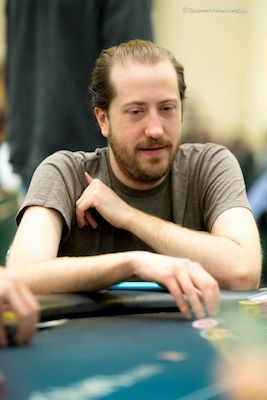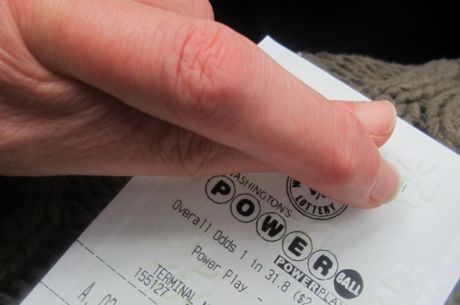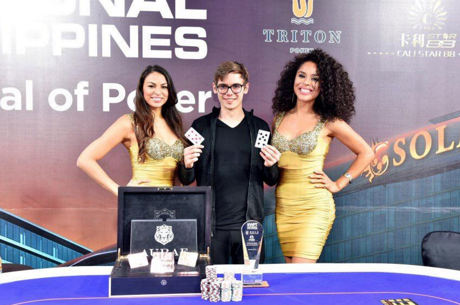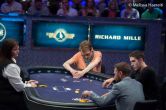Hand Analysis: Fedor Holz Seizes the Initiative Against Steve O��Dwyer

While the tournament circuit has moved on to Paradise Island in the Bahamas for the annual PokerStars Caribbean Adventure, the poker world is still buzzing about the recent hot streak of the young German Fedor Holz.
As summarized in the most recent Hold��em with Holloway, the $200,000 buy-in Triton Super High Roller Series $200,000 Cali Cup in Manila last week came down to a star-studded final table also featuring Dan Colman, Phil Ivey, Steve O��Dwyer, David Peters, Mike ��Timex�� McDonald, Devan Teng, and Phil Phua. Ultimately the young German bested them all. It��s been quite a recent stretch for Holz, with a win in the $100K buy-in World Poker Tour Alpha8 Las Vegas just a month ago capping off a breakout 2015.
The Triton SHR final table was broadcast on a live stream, and Chad wrote about some of the hands that went to showdown. As with much of poker, some of the most important hands that are played don��t get revealed. As I watched a hand that stood out for me was Hand #58, one in which Holz won a large pot after O��Dwyer tank-folded to a half-pot bet on the river.
Game designer and poker author Alex Weldon recently broke down the entire hand, with comments from PokerNews strategy contributor Andrew Brokos. I��d also like to take a deeper look at the hand, and in particular the river decision which presents us a spot that comes up frequently when you��re playing deep stacks late in a tournament. And because we don��t know what either Holz or O��Dwyer had, the hand allows us to look at how the hand played out without adjusting too much after the fact based on what cards the players actually held.
As we go through the hand, try to look at each bet, channel your inner Ed Miller, and think about the range of hands that each player is likely to have had at each step of the way.
Holz Bets Every Street
It��s down to four players, all with deep and fairly even stacks. The blinds are 25,000/50,000 with a 5,000 ante, meaning there is 95,000 in the pot preflop. Holz has around 2.8M to start the hand and O��Dwyer around 2.6M, so both are more than 50 BB deep. Worth noting as well are the remaining payouts (and big pay jumps), with $3,463,000 going to first, $2,309,000 to second, $1,405,500 to third, and $953,700 to fourth.
Holz raises to 125,000 from under the gun and O��Dwyer calls on the button, so there is 345,000 in the middle when the flop comes J?8?6?. Holz continues for 210,000, about two-thirds of the pot, and O��Dwyer calls.
The turn is the 9?, a card that could complete a flush or a straight. Holz bets again, this time 385,000 or just a touch over half the pot, and O��Dwyer calls again. Pot 1,535,000.

The river brings the A?. Holz commits almost 40% of his remaining stack with a bet of 720,000. O��Dwyer �� who has put 720,000 in by this point already �� tanks for a long time and then folds, leaving himself about 1.9 million.
What hands could O��Dwyer have possibly have had to have gotten that far and then to fold when getting 3-to-1 odds on his call?
Establishing Ranges from Actions
Although we never saw either player��s cards, their bets give us quite a bit of information. First of all, we can assume that both players are very good, and that they know that their opponents are also very good. It��s pretty fair to expect optimal play from each player, or at least human-like play that��s close to game theory optimal (GTO), given the cards and the tournament situation.
Holz was first to open, four-handed, so his range is pretty wide. Then again, he bet every street. Let��s say he could have any Broadway card combination that partially hit the flop, and survived to the river. He could also have a made flush, a straight, two pair, trips, or have caught the ace on the river to improve to a pair of aces after having bluffed the turn with A?Xx (i.e., the nut-flush draw).
O��Dwyer called on the button preflop with deep stacks, then called but didn��t raise on every street until the river. He could also have a wide range of hands, including big pairs, a missed straight draw, two pair, or a monster hand like a flush. However, which of these hands would he tank-fold on the river?
The easiest hand to see for O��Dwyer is a pair of jacks, perhaps with a straight draw or a flush draw on the turn �� something like Q?Jx, Jx10x, or possibly AxJx, although it��s hard to imagine he could fold top two pair here, so let��s strike out the latter.
A thorough analysis would call for us to write down all possible range combinations for both players which could plausibly get us to the river. Meanwhile some cards one player holds will block those from appearing in the other��s hand, so it gets really messy.
Some simpler questions to ask would include:
- How often is Holz bluffing the river?
- How often does he have a monster like a set, a straight, or (most likely) a flush?
- Does he bet with two pair?
- Does he bet if he were bluffing before, then rivered one pair of aces?
In the piece mentioned above, Andrew Brokos thinks that Holz bluffs most of his Kx10x-type missed draws, but that he usually has a flush, with which he makes the same bet. He probably also bets his two-pair hands, but he just check-calls with a pair of aces.
I think that Holz is betting all of his monster hands, as well as betting most of the time, or close to all of the time, with the rest of his range.

Given the tournament situation, it��s very expensive for O��Dwyer to raise all in without a monster. Holz often has a flush, so if O��Dwyer raises, it��s easy for Holz to fold anything that isn��t a great hand (unless there are tells or super-reads we don��t know about).
Therefore, I think that Holz seizes the initiative here, and bets most of the time with hands like two pair or a pair of aces made on the river.
It��s nice on paper to balance our range by putting hands into categories, then bet with some hands and check the others. But this isn��t how individual hands play out. You��re not sitting there thinking about what bucket the current hand fits into, as part of an equilibrium strategy. Instead, you��re thinking what percentage of the time do I bet right now if I want to end up with a balanced range in these types of spots overall?
A computer thinks this way also. Whether you��re messing around with counter-factual regret (CFR) or attempting to find good betting strategies with a neural network, your output is a probabilistic betting strategy for each game situation.
Here, if Holz barreled the flop and turn with A?Q?, I can see him betting the rivered top pair 80% of the time, or even closer to 100%. It��s a big hand, he just made a good river, and his opponent��s most likely hand is a pair of jacks, giving him a great price to call.
At the same time, those chips are precious, and Holz can so easily have a flush here. Either way, O��Dwyer has a really tough decision.
It��s also worth noting even Steve O��Dwyer doesn��t play in the final four of a $200K buy-in event every week. He��s won a bunch of these high roller tournaments �� and in fact just this week took down another in the $50K Single-Day High Roller at PCA �� and probably thinks that he has edge any time he can play a little bit longer. If the situation is at all close, I think he leans toward folding and preserving his stack.
Carpe Diem
This is the bigger lesson here �� the value of ��seizing the day.�� By making bets that are painful for your opponent to call, you grab the initiative in a hand. Imagine what O��Dwyer is feeling here with a weak two pair. He played it slow the whole way, and now he doesn��t want to put in half of his remaining stack against a likely flush. Even if he folds the winner just 30% of the time, that��s a huge gain for the player who bet an ace on the river.
In chess, you��re taught not to try to play perfectly, but rather to put challenges in front of your opponent. If your opponent then solves all of them, then that player deserves to win the game. It��s a lot easier to be making the challenges than to be trying to solve them all from the other side of the board. Even at the highest levels of poker, I think that the same remains true to some extent.
The last thing I��d like to say is that Holz set up this nasty river bet with great bet-sizing on the turn. He made a smaller-than-normal bet, but one that in order for O��Dwyer to raise he would still have to commit his stack. In other words, his opponent could not possibly fold a good hand on the turn, but he still would have a tough choice on many rivers, unless his hand were to improve. Out of position, Holz took the first mover��s advantage.
Over my years of tournament play, I��ve found that most good tournament players make their big decision on the turn, then tend to ��A-B-C�� the river. They will almost never bluff on the end, unless they were drawing and don��t have showdown value, with something like a missed straight. It��s usually an easy decision for an opponent holding top pair, or middle pair. Occasionally there��s a cooler.
But you can also play interesting rivers, too, and you can put a lot of pressure on your opponents on fifth street. O��Dwyer wasn��t Hollywooding. He either almost paid off with a hand like JxXx against a likely flush, or he made a big fold with two pair or a pair of aces on the river. Either way, there is a chance he made a mistake that cost him some tournament value, most of it to Holz��s benefit. That is why I don��t check a pair of aces on this river, or at least I don��t check it every time. Your opponent can make a huge mistake, only if you put him in that position.
Stay active. Put pressure on your opponents. Size your bets to make the follow-up bet �� a bet that your opponent doesn��t want to face. You don��t have to go all in to exert a lot of pressure, and you don��t have to be in position to take the initiative.
Nikolai Yakovenko is a professional poker player and software developer residing in Brooklyn, New York who helped create the ABC Open-Face Chinese Poker iPhone App.
Want to stay atop all the latest in the poker world? If so, make sure to get PokerNews updates on your social media outlets. Follow us on Twitter and find us on both Facebook and Google+!









